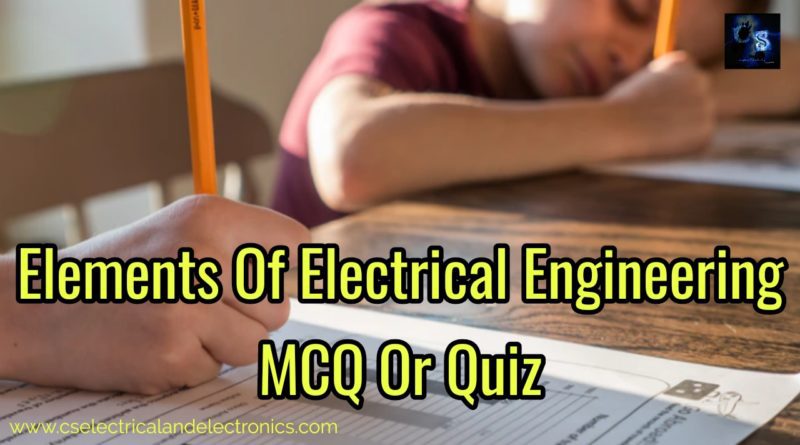MCQ Or Quiz On Elements Of Electrical Engineering
Hello guys, welcome back to my blog. In this article, I will discuss elements of electrical engineering MCQ or quiz, electrical quiz questions related to electricity, and current.
If you want an article on some other topics then comment us below in the comment section. You can also catch me @ Instagram – Chetan Shidling.
Also read – Basic Electrical Questions And Answers.
Elements Of Electrical Engineering MCQ
01. Which is the SI unit of power?
- henry
- coulomb
- watt
- watt-hour
Ans: c
02. The electric pressure is known as?
- resistance
- power
- voltage
- energy
Ans: c
03. The substances which offer low resistance and have a large number of free electrons are called?
- insulators
- inductors
- semi-conductors
- conductors
Ans: d
04. Which is not a poor conductor?
- Cast iron
- Copper
- Carbon
- Tungsten
Ans: b
05. In the following option which is an insulating material?
- Copper
- Gold
- Silver
- Paper
Ans: d
06. The conductor allows current through it is which property?
- resistance
- reluctance
- conductance
- inductance
Ans: c
07. The reciprocal of conductance is?
- resistance
- inductance
- reluctance
- capacitance
Ans: a
08. In a conductor, the resistance varies inversely?
- length
- area of cross-section
- temperature
- resistivity
Ans: b
09. If the temperature raises then the resistance of pure metal?
- increases
- decreases
- first increases and then decreases
- remains constant
Ans: a
10. If the temperature raises then the resistance of semiconductor?
- decreases
- increases
- first increases and then decreases
- remains constant
Ans: a
11. If the three resistance are connected in parallels such as 15 ohms, 10 ohms, and 30 ohms. The total resistance of the circuit is?
- 5 ohms
- 10 ohms
- 15 ohms
- 55 ohms
Ans: You guys comment below if you do comment I really appreciate you.
12. The electric current is detected by which instrument?
- voltmeter
- rheostat
- wattmeter
- galvanometer
Ans: d
13. In a circuit, a resistor of 30-ohm carries a current of 2 amperes. The voltage across the resistor is?
- 33 V
- 60 v
- 80 V
- 132 V
Ans: b
14. The bulb draws 300 mA and the voltage across it is 240 V. The resistance of the electric bulb is?
- 400 Ohm
- 600 Ohm
- 800 Ohm
- 1000 Ohm
Ans: c
15. If the resistance of one branch is 18 ohms and the resistance of a parallel circuit consisting of two branches is 12 ohms, what is the resistance of the other?
- 18 Q
- 36 Q
- 48 Q
- 64 Q
Ans: b
16. Four wires of the same cross-sectional area, the same material, and the same length, when connected in parallel, give a resistance of 0.25 ohm. Then the same 4 wires if connected in series the resistance will be?
- 1 Q
- 2 Q
- 3 Q
- 4 Q
Ans: Guys answer comment below.
17. The current of 16 amperes divides between two branches of the circuit in parallel of resistances 12 ohms and 8 ohms respectively. The current in each branch is?
- 6.4 A, 6.9 A
- 6.4 A, 9.6 A
- 4.6 A, 6.9 A
- 4.6 A, 9.6 A
Ans: b
18. The material which has a zero temperature coefficient of resistance?
- Manganin
- Porcelain
- Carbon
- Copper
Ans: a
19. Which statement is true both for a parallel and a series D.C. circuit?
- Elements have individual currents
- Currents are additive
- Voltages are additive
- Power is additive
Ans: d
20. The materials which have a negative temperature coefficient of resistance?
- Copper
- Aluminum
- Carbon
- Brass
Ans: c
21. The flow of a current in a conductor is due to the flow of?
- a. Protons
- b. Electrons and ions
- c. Charged particles
- d. Electrons
Ans is Electrons
22. The electric current is?
- a. The pressure difference between the two poles
- b. The random movement of electrons in a conductor
- c. Movement of free electrons predominately in one direction.
- d. The power that causes the drift of electrons
Ans is Movement of free electrons predominately in one direction
23. In the gases, the flow of current is due to?
- a. Positive ions and electrons
- b. Negative and positive ions
- c. Electrons only
- d. Electrons, positive ions, and negative ions
Ans is Electrons, positive ions, and negative ions
24. The ampere-second could be the unit of?
- a. EMF
- b. Charge
- c. Power
- d. Energy
Ans is Charge
25. The minimum requirements for causing the flow of current are?
- a. A power source and a bulb
- b. A voltage source and a conductor
- c. A voltage source, a conductor, an ammeter, and a switch
- d. A voltage source, a resistor, and a switch
Ans is A voltage source and a conductor
26. The current which is considered dangerous for the human body is?
- a. one milli-ampere
- b. 25 milli-ampere
- c. 50 milli-ampere
- d. 0.5 ampere
Ans is 50 milli-ampere
27. The voltage is a form of?
- a. Kinetic energy
- b. Potential energy
- c. Both
- d. None of the above
Ans is Potential energy
28. One volt is equal to?
- a. One coulomb per joule
- b. One joule per coulomb
- c. One coulomb per second
- d. Work was done in transferring a charge of one coulomb
Ans is One joule per coulomb
29. The electric pressure is also called the?
- a. Resistance
- b. Voltage
- c. Power
- d. Energy
Ans is Voltage
30. The ratio of voltage and electric current in a closed circuit?
- a. Remains constant
- b. Varies
- c. Increases
- d. Falls
Ans is Remains constant
31. If in a circuit the voltage is reduced to half and resistance is doubled, the current will become?
- a. Four times
- b. Double
- c. A quarter
- d. Half
Ans is A quarter
32. The condition for the validity under ohm’s law is that the?
- a. The temperature should remain constant
- b. The current should be proportional to voltage
- c. Resistance must be wire wound type.
- d. All of the above
Ans is The temperature should remain constant
33. A linear resistor is one which obeys?
- a. Ampere’s law
- b. Lenz’s law
- c. Ohm’s law
- d. Kirchhoff’s law
Ans is Ohm’s law
34. The resistance of the conductor always increases if?
- a. Temperature is reduced
- b. Temperature is increased
- c. Number of free electrons available become less
- d. Number of free electrons available become more
Ans is Number of free electrons available become less
35. The resistance of the wire varies inversely?
- a. Area of x-section
- b. Length
- c. Resistivity
- d. Temperature
Ans is Area of x-section
36. The pure metal generally have?
- a. High conductivity and low-temperature coefficient
- b. High conductivity and large temperature coefficient
- c. Low conductivity and zero temperature coefficient
- d. Low conductivity and high-temperature coefficient
Ans is High conductivity and large temperature coefficient
37. Which of the following material possesses the least specific resistance?
- a. Aluminum
- b. Copper
- c. Silver
- d. Iron
Ans is Silver
38. With the rise in temperature, the resistance of carbon?
- a. Increases
- b. Decreases
- c. It becomes zero
- d. Remains unchanged
Ans is Decreases
39. Which of the following quantities are the same in all parts of a series circuit?
- a. Voltage
- b. Power
- c. Current
- d. Resistance
Ans is Current
40. The element of electric heater is made of?
- a. Copper
- b. Aluminum
- c. Nichrome
- d. Carbon
Ans is Nichrome
I hope this article may help you all a lot.
Tags: Electrical Interview Question Related to Current And Electricity, Electrical Quiz Questions, MCQ Or Quiz On Current And Electricity, Electrical Objective Questions.
Author Profile
- Chetu
- Interest's ~ Engineering | Entrepreneurship | Politics | History | Travelling | Content Writing | Technology | Cooking
Latest entries
 All PostsApril 29, 2024Top 11 Free Courses On Battery For Engineers With Documents
All PostsApril 29, 2024Top 11 Free Courses On Battery For Engineers With Documents All PostsApril 19, 2024What Is Vector CANoe Tool, Why It Is Used In The Automotive Industry
All PostsApril 19, 2024What Is Vector CANoe Tool, Why It Is Used In The Automotive Industry All PostsApril 13, 2024What Is TCM, Transmission Control Module, Working, Purpose,
All PostsApril 13, 2024What Is TCM, Transmission Control Module, Working, Purpose, All PostsApril 12, 2024Top 100 HiL hardware in loop Interview Questions With Answers For Engineers
All PostsApril 12, 2024Top 100 HiL hardware in loop Interview Questions With Answers For Engineers








